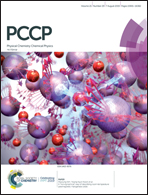High energy-storage density of lead-free (Sr1−1.5xBix)Ti0.99Mn0.01O3 thin films induced by Bi3+–VSr dipolar defects
Abstract
Capacitors with high energy storage density, low cost, ultrafast charge–discharge capability, and environmental friendliness are in high demand for application in new energy vehicles, modern electrical systems, and high-energy laser weapons. Here, lead-free (Sr1−1.5xBix)Ti0.99Mn0.01O3 (x = 0.01, 0.05, 0.1) thin films grown on Pt/Ti/SiO2/Si substrates were obtained by a sol–gel method. All the thin films have a relatively high dielectric breakdown strength (BDS) due to the added 1% Mn and pinched polarization hysteresis loops can be observed in 5 and 10 mol% Bi-doped SrTiO3 thin films. The ferroelectric behaviors of the Bi-doped SrTiO3 thin films come from the rotation of the TiO6-octahedra induced by the formation of Bi3+–VSr dipolar defects. With the increase of doping concentration, the Pmax–Pr values of the Bi-doped SrTiO3 thin films increased dramatically and can reach 34.3 μC cm−2 upon doping with 10 mol% Bi. A high recoverable energy-storage density of 24.4 J cm−3 with excellent temperature stability was obtained for the 10 mol% Bi-doped ST thin film, which shows that the (Sr0.85Bi0.1)Ti0.99Mn0.01O3 thin film is a promising candidate for high-power energy storage applications. This finding demonstrates an improved energy density of SrTiO3-based thin film systems and a reasonable explanation for the source of the ferroelectricity based on first-principles calculations is given.



 Please wait while we load your content...
Please wait while we load your content...